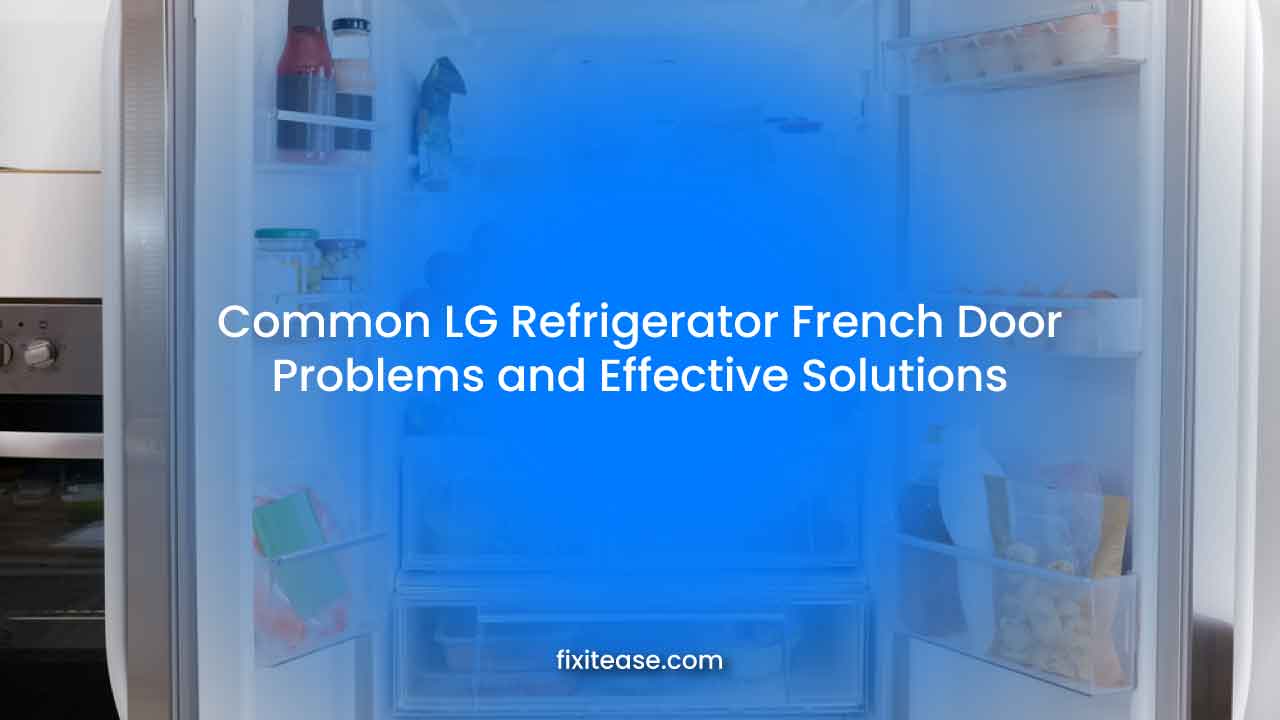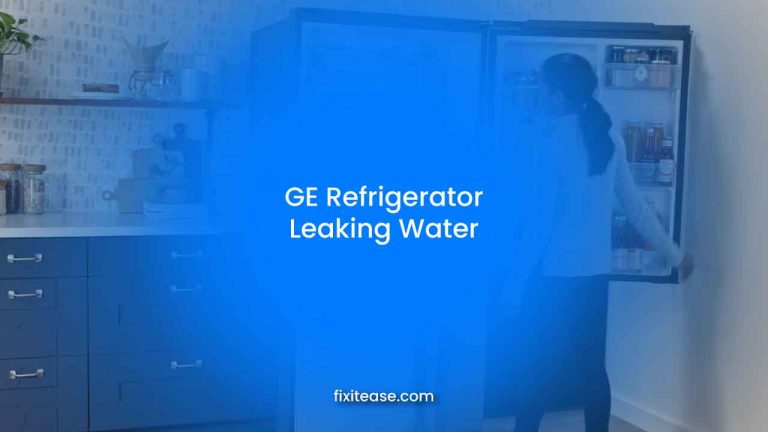Common LG Refrigerator French Door Problems: Here’s How to Fix Them
LG French Door refrigerators, while stylish and functional, often face various issues. From inconsistent cooling to ice maker malfunctions, these problems can disrupt your daily life.
These refrigerators are a staple in many homes, known for their sleek design and advanced features. However, even the best appliances have their quirks. Temperature irregularities, water dispenser troubles, and noisy operations are just a few of the challenges you might encounter.
I aim to shed light on these common problems and offer effective solutions. Understanding these issues is crucial, whether it’s a quick DIY fix or a call for professional help. Let’s work together to keep your LG French Door refrigerator running smoothly, ensuring it remains a reliable part of your daily kitchen experience.
Common French Door Problems in LG Refrigerators (With Solutions)
LG French Door refrigerators can run into problems like any appliance. Understanding these issues is key to keeping your fridge in good shape. Let’s look at the most common problems that French doors of these refrigerators face and the symptoms that usually accompany them. This way, you’ll be better equipped to identify and address any issues.

1. Misalignment and Its Consequences
If your LG fridge’s doors aren’t lining up right, you’ll see gaps that shouldn’t be there. This can make your fridge feel warmer than it should, or you might find patches of frost. It’s a sign that your fridge is working too hard to keep cool while losing cold air.
Fixing Misaligned LG French Door Refrigerator Doors
- Level the Fridge: Adjust the legs at the bottom to ensure the refrigerator is perfectly level.
- Adjust the Hinges: Check the door hinges and adjust them as needed – sometimes, they just need a little tightening or loosening.
- Manual Realignment: If the doors are still off, gently push them back into the correct position.
- Regular Checks: Keep an eye on door alignment as part of your regular fridge maintenance to prevent future issues.
2. Seal and Gasket Issues
A worn or damaged seal might not be immediately visible, but you’ll feel its effects. The most common sign is the fridge struggling to maintain the right temperature. You might notice your food isn’t staying as fresh as it should, or there’s unexpected condensation or frost inside. This happens because the damaged seal allows cold air to escape, making the fridge work harder and use more energy.
To Fix Seal and Gasket Issues:
- Inspect the Seals: Regularly check the door seals for any signs of wear, tear, or damage.
- Clean the Seals: Sometimes, simply cleaning them can improve efficiency. Use a mild soap and water solution.
- Replace if Necessary: If the seals are damaged, replacing them is usually the best solution. This can often be done easily and is crucial for maintaining the fridge’s efficiency.
- Keep Them Dry: After cleaning, make sure the seals are dry to prevent mold and mildew buildup.
3. Door Closure and Latch Problems
If the doors don’t close properly or the latch isn’t engaging, it can lead to similar problems as a misaligned door or a faulty seal. The most obvious sign of this issue is a door that won’t stay shut or seems loose. This can cause the fridge to lose cool air, leading to inefficient cooling and increased energy usage.
To Tackle Door Closure and Latch Problems:
- Check the Latch Mechanism: Ensure the latch is not obstructed and is functioning correctly. Sometimes, debris or a simple misalignment can prevent it from engaging properly.
- Adjust the Doors: If the doors hang unevenly, adjusting them can help ensure a proper seal when closed.
- Tighten Loose Components: Over time, screws and fittings can become loose. Tightening these can often resolve closure issues.
- Lubricate if Necessary: Occasionally, the latch or hinges might need lubrication to function smoothly.
Auto-Close Feature Malfunctions
The auto-close feature in LG French Door refrigerators ensures the doors close independently, but if it stops working, you might find your fridge door unexpectedly open. This affects the cooling efficiency and increases energy bills and food spoilage.
To Address Auto-close Feature Malfunctions:
- Check for Obstructions: Ensure nothing is blocking the door path. Sometimes, even small items can prevent the auto-close mechanism from working.
- Inspect the Door Alignment: Misaligned doors can hinder the auto-close feature. Adjusting the alignment might solve the problem.
- Clean the Tracks and Hinges: Dirt and grime can accumulate in the tracks and hinges, affecting the smooth operation of the auto-close feature. Cleaning these parts can often restore functionality.
- Reset the Refrigerator: In some cases, resetting your LG refrigerator can help recalibrate the auto-close feature. This is usually done by unplugging the fridge for a few minutes and then plugging it back in.
Some Other French Door Challenges in LG Refrigerators
LG French Door refrigerators sometimes face unique challenges beyond the usual wear and tear. These issues, ranging from water leakage to sensor malfunctions, can impact the efficiency and convenience of your appliance. Being aware of these less common but significant problems is crucial for maintaining the optimal performance of your LG refrigerator.
- Door Alarm Issues: The door alarm, designed to alert you when the doors are left open, may malfunction, either sounding off erroneously or not working when needed.
- Water Leakage Around Doors: Water leaking near the French doors can indicate a blocked defrost drain or issues with the door’s seal.
- Difficulty in Switching Between Freezer and Refrigerator Modes: In models with convertible zones, there might be problems switching the compartments between freezer and refrigerator modes.
- Door Bin Problems: The bins attached to the French doors can sometimes break, become loose, or fail to stay in place, affecting storage and door closure.
- Rubber Gasket Wear: Over time, the rubber gasket around the doors may wear out or tear, leading to air leaks and efficiency problems.
- Condensation Inside the Fridge: Excessive condensation inside the refrigerator, particularly near the French doors, can indicate a problem with the door’s insulation or sealing.
- Noise When Opening or Closing: Squeaking or other noises when opening or closing the French doors can be due to hinge issues or the need for lubrication.
- Sensor Malfunctions: The sensors that detect whether the doors are open or closed can sometimes malfunction, leading to cooling issues or the interior light staying on.
- Handle Issues: Loose or broken handles on the French doors can make opening and closing the doors difficult and may require tightening or replacement.
- Frost and Ice Accumulation: Sometimes, frost or ice can build up around the French door area, indicating a seal problem or humidity control issues.
Preventive Measures for Long-Term Door Health
Keeping the doors of your LG French Door refrigerator in top shape is easier than you think. It’s all about regular checks and simple care. Here’s what you can do to prevent door-related problems and keep them working smoothly:
- Regular Cleaning: Wipe down the door seals with a soft cloth and mild soap. Dirt and food particles can cause seals to weaken over time.
- Check Alignment Monthly: Take a quick look to ensure the doors are properly aligned once a month. They won’t seal correctly if they’re off, leading to cooling loss.
- Lubricate Hinges Annually: Apply a small amount of lubricant to the door hinges once a year. This keeps them moving smoothly and prevents squeaking.
- Avoid Slamming Doors: Gently close the doors. Slamming can damage the hinges and alignment over time.
- Keep Door Bins Light: Don’t overload the door bins. Too much weight can strain the hinges and affect door closure.
- Inspect and Replace Gaskets as Needed: If the gaskets are worn or damaged, replace them to ensure a good seal.
- Balance the Fridge: Make sure your refrigerator is balanced. An unbalanced fridge can put extra stress on the doors and hinges.
- Avoid Hanging on Doors: Discourage kids (and adults) from hanging on the refrigerator doors. This can lead to misalignment and hinge damage.
- Regularly Check Door Seals: Inspect the seals around the doors for any cracks or gaps. A broken seal can lead to energy loss and moisture problems.
- Control Room Temperature: Keep your kitchen at a consistent temperature. Extreme temperature changes can affect the door materials and sealing efficiency.
- Be Mindful of Open Door Time: Avoid when the fridge doors are left open. Prolonged exposure to warm air can strain the cooling system and affect door function.
- Check for Loose Screws: Periodically tighten any loose screws on the door handles and hinges to ensure everything stays secure.
- Monitor Auto-Close Feature: If your model has an auto-close feature, check it regularly to ensure it’s functioning correctly.
- Clean the Gasket Area: Debris and spills can accumulate in the gasket area, leading to a poor seal. Clean this area gently but thoroughly.
FAQ
What causes frost buildup in my LG French Door fridge?
Frost buildup often occurs when a gap in the door seal allows moist air inside. Regularly check and clean the door seals to prevent this. If the problem persists, it might be due to a malfunctioning defrost system, which would require professional attention.
How do I fix the ice maker in my LG French Door refrigerator?
If your ice maker isn’t working, ensure it’s turned on and the water line isn’t blocked or frozen. Sometimes, resetting the ice maker or clearing any ice clumps can get it back in action. If these steps don’t work, it might be a more complex issue like a water filter or valve problem.
Why is the water dispenser on my LG fridge not working?
A non-functioning water dispenser could be due to a clogged water filter, low water pressure, or a kink in the water line. Start by replacing the water filter and checking for any bends in the water line. If these don’t help, the issue could be with the dispenser mechanism itself.
My LG French Door refrigerator is making strange noises. What should I do?
Unusual noises can be due to various reasons, like an unbalanced fridge, loose components, or a malfunctioning compressor. Make sure your fridge is level, and check for any loose parts. If the noise persists, especially a loud humming, it might be the compressor, which requires professional repair.
How can I fix the auto-close feature on my LG French Door refrigerator?
If the auto-close feature isn’t working, check for any obstructions in the door path and ensure the fridge is level. Lubricating the hinges and cleaning the tracks can also help. The door alignment may need professional adjustment if these steps don’t resolve the issue.
Conclusion
Taking care of the doors on your LG French Door refrigerator is a simple yet crucial part of maintaining your appliance’s efficiency and longevity. By incorporating these easy-to-follow tips into your regular home maintenance routine, you can avoid common door-related issues and ensure your fridge continues functioning at its best.
Remember, a little attention goes a long way in keeping your refrigerator running smoothly and your food fresh. So, give those doors the care they deserve, and they’ll serve you well for years.







